Strawberry Strawberries Wild Fragaria
Ah, Strawberries – those beautiful little berries with the shiny red, seed dimpled skin. We pick them, eat them and enjoy them all by themselves and are tempted to transfer their delicious flavor and texture by transforming them into everything from ice cream, to smoothies, to jam, to candy, to compote or whatever else the imagination wants to turn this versatile little berry into. We often put them into pastries and, for those special occasions, we turn them into living art by dipping them into chocolate and give them to our loved ones as a token of our affection. It would seem that we love strawberries any way we can get them.
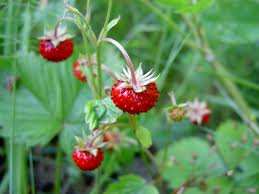 Strawberries naturally grow wild all over the Northern Hemisphere and in parts of South America. They have been cultivated in royal botanical gardens as well as in herb gardens all over Europe for several centuries. The botanical name for the strawberry is Fragaria, which has several wild and hybrid varieties. The wild variety found in Europe is the; Fragaria vesca which has several variations largely due to where they happen to be growing. This European or Forest strawberry and it’s close cousin, the Alpine strawberry, vary by adaptation to their respective environments, as have the different varieties growing in the wild across the entire Northern hemisphere. Cultivators, botanists and plant enthusiasts have further hybridized the original plants into still different varieties to take advantage of the specific qualities from the various species.
Strawberries naturally grow wild all over the Northern Hemisphere and in parts of South America. They have been cultivated in royal botanical gardens as well as in herb gardens all over Europe for several centuries. The botanical name for the strawberry is Fragaria, which has several wild and hybrid varieties. The wild variety found in Europe is the; Fragaria vesca which has several variations largely due to where they happen to be growing. This European or Forest strawberry and it’s close cousin, the Alpine strawberry, vary by adaptation to their respective environments, as have the different varieties growing in the wild across the entire Northern hemisphere. Cultivators, botanists and plant enthusiasts have further hybridized the original plants into still different varieties to take advantage of the specific qualities from the various species.
It is interesting to note that the strawberry is technically not a berry. But, let’s leave that sort of fine detail to the botanists to quibble over.
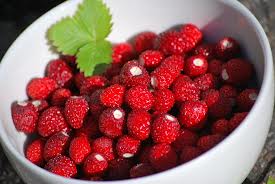 It might surprise some to know that the strawberries we see at the fruit market are not what strawberries have always looked like. Wild strawberries are the ancestors of what are now being cultivated as strawberries. They were much smaller. It took a lot of picking to fill a basket with them but, you were greatly rewarded for your efforts. Those little strawberries were more fragrant, sweeter and so much richer in strawberry flavor and effect as to greatly overshadow their more modern hybridized cousins in quality. You can still find these wild strawberries growing in sunny patches in forests and at the edge of fields.
It might surprise some to know that the strawberries we see at the fruit market are not what strawberries have always looked like. Wild strawberries are the ancestors of what are now being cultivated as strawberries. They were much smaller. It took a lot of picking to fill a basket with them but, you were greatly rewarded for your efforts. Those little strawberries were more fragrant, sweeter and so much richer in strawberry flavor and effect as to greatly overshadow their more modern hybridized cousins in quality. You can still find these wild strawberries growing in sunny patches in forests and at the edge of fields.
For understandable economic reasons, the strawberries that are now being commonly cultivated are called “garden strawberries;” a hybrid species first cultivated in Western France and likely a cross between the native North American and Chilean varieties. They are often not as sweet, as flavorful or as aromatic as their much smaller cousins but, they are certainly a lot larger and provide a greater volume in yield.
With the current annual strawberry yield at over 4.5 million tons and trending upwards, strawberries are a worldwide favorite. One only hopes that along with the quantity, that the quality is also being preserved. In a GMO (Genetically Modified Organism) infested world one can never be too sure or, take anything to do with food for granted anymore.
Commercially, if the climate they are being cultivated in will allow them to fully ripen, their flavor is still quite enjoyable. Yet, for entirely practical reasons, strawberries are picked before they are fully ripe so their natural sugars may not have fully developed when bought. Leaving them on the counter for a few days to allow them to develop their full, succulently sweet flavor is sometimes necessary.
 Strawberries are prone to pests and are sprayed with pesticides so, it’s a good idea to let them soak for about 5 minutes in some water with some added vinegar to help remove some of the residue before eating them. These days this is good procedure to practice anyway and there is no transfer of acidic flavor either.
Strawberries are prone to pests and are sprayed with pesticides so, it’s a good idea to let them soak for about 5 minutes in some water with some added vinegar to help remove some of the residue before eating them. These days this is good procedure to practice anyway and there is no transfer of acidic flavor either.
Strawberries do not have a very long shelf life and are best picked, bought, eaten, kept cool, dried, made into something or preserved as fast as possible if you want to enjoy them before they spoil.
Strawberries can also be frozen to be eaten at a later time. They can then be made into what ever you’d like. Mixed with some frozen bananas and pureed in a strong blender or food processor makes for a great, almost ice cream like smoothie.
You can always grow them yourself by just buying seeds or keeping the seeds on the surface of the strawberries for planting. The soil needs to be prepared and well composted and because we’re dealing with an already artificial situation a little fertilizer may be needed. It may not be a very glamorous thing to say but steer manure, because of it’s natural nitrogen content, makes for a great fertilizer and soil conditioner for most things to grow better and strawberries are no exception to that rule. If the soil is “rich” from good compost there is no reason why a good backyard crop of strawberries would not grow right at home. Because they are grown at home and can be picked when they are ripe, they should also be tastier than the ones you might normally buy.
Nutritional Value and a Quirk of The Strawberry
The strawberry, has been chemically analyzed and, like most fruits or berries it is made up of a full spectrum of known and familiar nutritional elements. Strawberries contain several B vitamins, amino acids, vitamins C, E and K, as well as calcium, iron, magnesium, manganese, phosphorus, potassium, sodium and zinc. It is to be expected that strawberries grown in the wild will be more potent in their nutritional content.
Strawberries contain a good amount of potassium, vitamin C and manganese. Like most fruit they are naturally high in fibre and antioxidants. And, for the calorie conscious, strawberries contain around 50 calories in a one cup serving.
These nutrients are all very friendly and helpful to the body. They are not too much different from what is in other fruits yet, even though most people can eat strawberries without any problems, strawberries are known to produce what is being called an “allergic reaction” in some.
It would seem that if all we had to go by is the vitamins and minerals in strawberries, there would be nothing to worry about so, why do strawberries have this effect on some people?
The reaction to strawberries for those who are prone is like a lesser anaphylactic episode (pseudoanaphylaxis). This effect associated with strawberries is about the same effect that those who are prone also have from eating other fresh fruit or vegetables. Typically, this affects the lips, mouth, ear canal and throat (oral allergy syndrome) with an itching or burning sensation that can extend to the eyes, nose or skin. Skin rash can also be part of the same effect.
Although this is not considered to be a true or full allergic response, it could potentially be life threatening to some, so care should be taken and a health care provider should be consulted in such cases.
Why these type of reactions happen is admittedly not completely understood in the orthodox medical community but, the blame is being cast onto a protein that is believed to be responsible for the reddening of the strawberry as it ripens. As is often the case, the search for a dreaded pathogen is on. The answer may be a little simpler and may have more to do with the bodies own immune response than the strawberry itself.
So, Is It Or, Isn’t It The Strawberries?
It would seem that reactions like these are happening with increasing frequency in our times; not only to strawberries but also other otherwise completely normal, natural foods in their raw unprocessed state. It is also very curious and interesting to note that people have historically been eating strawberries for thousands of years without incidents of these types ever having been recorded before very recently.
It could be suggested that what may be provoking these effects may not be the strawberry itself but, what is chemically inside the body’s of the people of today. It is common knowledge that modern people have at least 200 traceable chemicals that had never before existed in Nature coursing through their veins at birth. Who or what is responsible for that?
The strawberry cannot help being what it is. It’s naturally detoxifying effect may indeed be a catalyst in these “allergic” effects on some but, few could argue that the changes in our environment, living circumstances and lifestyle choices are not somehow related to this now very common phenomenon. As recently as a very short 60 years ago, these type of things did not happen with any frequency.
Like with so many other fruits or foods that are similar to the strawberry the nutritional breakdown is similar but, besides being nutritive, why each food produces a specific bodily effect is often beyond simplistic chemical analysis.
A lot of the chemical analysis of fruits like strawberries is not to find its nutritional usefulness or health benefits. It’s to find ingredients that can be synthesized into products. With strawberries, the main interest is to mimic the flavor and fragrance of the strawberry so that it can be added to enhance artificial foods or perfumery. You would think that that could be acquired by simply growing the strawberry in the best possible manner and then distilling them. But, no – not in the our modern world. Today, synthetic always seems to trump the natural, even if questionable.
A Little Strawberry Story
Over 30 years ago when I was not well, I had taken care of myself by changing my diet. After reading a few books and having sought health advice, I voluntarily started eating raw fruits and vegetables to help myself much in the way as the video “Fat, Sick and Nearly Dead” indicates. In time I got completely well and as I had been eating raw fruits and vegetables continuously for over two years, I thought nothing of feasting on nothing but fresh strawberries while they were in season.
To my complete surprise, after eating only strawberries for about two to three days I started to notice that my gums were getting sore and bleeding. I had never had this happen before with anything else I had ever eaten. I didn’t feel weak, malnourished or sick so, I did not immediately suspect the strawberries. So, I started thinking and looking for answers.
This was not what some might consider a typical allergic reaction to something in the normal sense. I had had experiences with what are known as “healing crisis” before from detoxifying while eating mainly raw fruits and vegetables but, they were minor and entirely different.
Chemically based explanations seemed to come up short. As is the case with most foods and plants that have been commonly considered as foods, what they do to the body is generally not fully explainable through simple chemistry. All I could conclude was that the strawberries were indeed detoxifying me by targeting a very specific toxin type. As per Traditional Herbal Theory, when provoked, the body moves its toxins into the stomach as a pre-stage to their eventual elimination. If they are volatile they can affect inside of the mouth and the gums.
This concept, although understood quite well for the past few hundred years in the alternative health community, is still in it’s infancy in modern medicine. It is only recently being mentioned by the “celebrity” doctors who are promoting their books, weight loss or detox systems that had been pioneered by holistic practitioners long before them.
 After giving it a break for about a day or two. I started eating strawberries as before, without any further incident ever since. It would seem that although this innocent little strawberry has people reacting to it in what some would call an allergic reaction, in traditional herbal theory this effect of the strawberry represents a detoxifying effect.
After giving it a break for about a day or two. I started eating strawberries as before, without any further incident ever since. It would seem that although this innocent little strawberry has people reacting to it in what some would call an allergic reaction, in traditional herbal theory this effect of the strawberry represents a detoxifying effect.
In fact, Carl Lennaeus (1707–1778), the Swedish botanist and physician responsible for the formal protocol for how all plants and species are named was among many in his day who would successfully treat gout and urinary stones with nothing more than extended strawberry fasts. It would seem that the simple detoxifying effect of strawberries has been commonly understood and recognized for quite some time.
This strawberry fasting concept is or, at least was practiced in Europe in varying degrees of strictness. It was not uncommon in Europe when strawberries were in season for people to have taken one day a week to eat nothing but strawberries for that day. They would portion out three servings of about 4 oz of strawberries to be eaten three times that day. In Europe, the benefits of these practices have been accepted and confirmed. In North America, however, it is just one more piece of otherwise useful but entirely lost or ignored knowledge. Traditional Concepts and Uses For The Strawberry
Nicholas Culpepper, Fr. Sebastian Kneipp and Fr. Johann Kuenzle all mention that strawberries are generally cooling to the blood, liver, spleen and stomach and by extension are also generally good for inflammations because of it.
Kuenzle recommended that strawberries should be eaten if the stomach is weak. They should be mixed with a little red wine (blood) and some sugar or honey (spleen). This was to be prepared when strawberries were in season and eaten before meals to feed the stomach’s moisture prior to eating the main meal.
It was understood even then that the stomach and liver work cooperatively with the kidneys to maintain their necessary moisture for the sake of their respective digestive and detoxification functions. The healers of the day recognized the cooling and moistening principle in strawberries and the effect they had on the stomach and liver through the aid and in cooperations with the kidneys. They simply used the wild strawberry leaf and root as a tea to address these problem to great benefit.
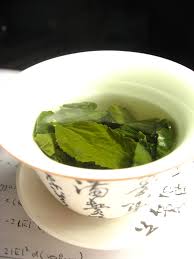 Both Kunzle and Kneipp also recommended that a tea made with “as many dried strawberry leaves as you can pick with three fingers,” steeped in hot water for 15 minutes, strained and with a little sugar or honey added is helpful for kids who are weak and sickly.
Both Kunzle and Kneipp also recommended that a tea made with “as many dried strawberry leaves as you can pick with three fingers,” steeped in hot water for 15 minutes, strained and with a little sugar or honey added is helpful for kids who are weak and sickly.
Interestingly, Sebastian Kneipp recommended strawberries for those who seem to have an almost unquenchable thirst and who suffer from an “uncomfortable sensation of internal heat.” What Kneipp is describing is very similar, if not identical to the Oriental Yin Depletion concept. Given the cooling effect of strawberries, it would seem that his connection is quite correct.
It was also very obvious to the healers of times past that because the kidneys eliminate the waste waters of the body as urine, that they must also work with the “waters” of the body in general. For this reason, in Traditional Herbal Theory, problems that were “gouty” and rheumatic or, urinary tract, bladder and genital related are all logically linked to kidney functions because they all have to do with the “waters” of the body. Gout, sciatica or rheumatic issues in particular, having to do with waters that have been contaminated from weakened kidney functions in a way that renders them “sour” or, “bitter,” as Paracelsus put it, making them irritating or painful to the fibers of the body. By cleaning these waters through kidney function support their effects are removed.
Given that the kidneys work with the waters of the body logically, their detoxify effect is through those waters from the function of the kidneys; strawberries simply enhancing that effect by aiding the kidney functions. This means that in addition to being cooling and aiding to the kidney’s functions; strawberries have also been traditionally known to be detoxifying and helpful for the problems just mentioned above.
Furthermore, the already cooling effect of strawberries is even more enhanced, because by helping eliminate pathogens, the reason for inflammations is being removed. With their removal, the property of cooling is freed from being detoxifying to be more balsamically soothing to the effected area. It is also within the scope of the functions of the kidneys to assist in the “downward” elimination of the waste of the body, making the strawberry and it’s parts also somewhat laxative.
And, before going further, you might be wondering, “what’s all this “cooling” about?” To a Western person this is not a very familiar concept, especially in the context of health and nutrition so, let’s just lightly touch on it.
The Cooling Effect: What It Means And How It is Put To Good Use
 In order for a strawberry to be “cooling,” a cooling principle must be active within it. This idea is ancient and based on the concept of the “pair of opposites;” the evident polarity of and in all things.
In order for a strawberry to be “cooling,” a cooling principle must be active within it. This idea is ancient and based on the concept of the “pair of opposites;” the evident polarity of and in all things.
The “cooling energies” exist in a dynamic equilibrium together with the “warming energies” of the body. Each is maintained and kept in equilibrium through the foods we eat. When the equilibrium is too one sided we commonly experience it as a mild or severe health disturbances.
All you have to do to see this principle in action is not drink enough water or, not water your plants when it’s hot outside. In a very short time the heat becomes over active, overcoming the water; drying everything out to the point of becoming life threatening! Conversely, if there is too much water an equally destructive cycle starts, the effects of which being related to the over abundance of water.
It is enough to know that what we commonly know as water or moisture is not identical to the “cooling principle” (Yin, Water Element) itself. It is only analogous to it. All that matters here is to understand the dynamic relationship between it and it’s warming counterpart.
These cooling and warming energies of life are natural forces; one existing within the other, each feeding the other. If one is deficient, the other is also weakened. This means that in matters of health, when feeding one, the other must also be considered so that the equilibrium between them is maintained.
To identify where and when these active forces in Nature were present in plants, animals and minerals, the ancients used various allegorical terms to classify them.
The people of those times, in both the East and West, were close to Nature and observed natural cycles, drawing conclusions that most might not make as readily today.
From their cosmology and keen observance they developed a system that was partly mystical and partly empirical to make these determinations with surprising scientifically proven accuracy.
 When these people lived, the terminology to do with plants and their uses were based and organized around these principles. There were also varying degrees of refinement in both the understanding and application of these principles between East and West.
When these people lived, the terminology to do with plants and their uses were based and organized around these principles. There were also varying degrees of refinement in both the understanding and application of these principles between East and West.
For example: Culpepper would very matter-of-factly state of strawberries that, “Venus owns this herb.” Without a concept of classical thinking most would have no clue what to make of this in today’s parlance. Yet, from this alone, it was understood that strawberries are related to general kidney functions, they are cooling, generally feed the cooling energies and are somewhat sympathetic to the feminine principle as well.
This is NOT to be mistaken for astrology!! It was a classical symbolic metaphor used for the classification and identification of the natural properties of things. From this classification and a little more experience with the plant, Culpepper and others who understood the terminology could recommend that the roots and leaves of the strawberry be boiled, steeped or distilled for their properties to be reliably employed.
With some greater refinement and understanding of ingredients, red wine could be added to the water to further drive the effects towards generally reducing heat in the liver, blood, kidneys and bladder. In this way the parts of the strawberry could also be used to reduce the menstrual flow by acting on the spleen. This basic concept also aligns with TCM.
The properties of plants was determined and classified by how the plant looked, tasted, smelled, where it grew and when, by it’s color and it’s general effects when ingested. The more gifted among them deduced the nature of strawberries to be cooling, therefore mildly anti-inflammatory and generally aiding to the kidneys functions and likely detoxifying because of it.
Note: The best among these people were not naive in the least and very far from stupid. They knew what was edible and what wasn’t. They already had a pretty good idea what to expect from the plant just by looking at it.
By this logic, the cooling nature of the juice of the berry, as well as the distilled water or decoction made from the leaves and roots can be put onto sores or ulcers to clean them and aid in their healing.
This fundamentally nurturing and nutritive “cooling principle” present in strawberries is very subtle, making it helpful in ailments that are consumptive or depleting in their nature. To understand this better, imagine plants that have been deprived of water and have become somewhat thinner and wilted and how watering them normalizes them. In similar fashion, strawberries can assist in the maintaining or the restoring of proper bodily weight through their cooling and moistening effect.
There are thousands of foods and herbs for the kidneys; some are cooling like strawberries but some are warming like asparagus. Why they should both provide similar benefits despite their opposite nature is interesting.
As a general rule heat is active and coolness is passive but, both can be beneficial when used appropriately. It is understandable that the kidney activity provoked by the warmth of asparagus is different from the kidney activity provoked by the cooling effect of strawberries. They both help to strengthen and detoxify through the effect of the kidneys and the general dominance of the kidneys over the waters of the body.
Warming energy invigorates and in general provokes functions. In the kidneys, it helps dissolve crystallized mineral deposits that have precipitated out of solution from the waters of the body that had become contaminated, back into those waters to be evacuated by the kidneys. It goes without saying that if the kidneys are already too warm as in the case of a kidney infection that to add more heat to them would not be a good idea.
Cooling and moist energy generally revitalize and cleanse too but, by a different action. It works by bringing moisture to areas that have been made drier than normal and aggravated by the similarly deposited minerals that have “soured” the bodily waters and by diluting them helping to dissolve them. Water alone cannot do that.
It was mentioned that the warm energy feeds the cool energy and vice versa. Therefore, the warmth of the asparagus feeds the cooling energies as much as the coolness of the strawberries feeds the warming energies. Each helping the other to stimulate the general functioning of the kidneys in a balanced manner.These concepts remain valid but are foreign to the modern medical model.
An imbalance between these energies can manifest as water retention, dizziness, skin rashes, inflammations, gout, arthritis, sciatica, lower back ache, Kidney pain, incontinence, impotence, feeling cold, having pain in the bones, feeling weak in the knees, feeling pains in the soles of the feet, feeling mentally weak, having little will power, etc – depending on which energy is deficientor predominant.
On Being Seasonal
It is rather humbling that in Nature things come into season and grow in an unchanging order that we have absolutely no control over. The people of old realized that, took advantage of it and drew several logical and beneficial conclusions from it.
With the coming of Spring, they realized that in order for Nature to awaken Her vegetative might, a strong enough force needed to be present to do it. They concluded that the plants which grew, flowered or fruited at a particular time, did so for that reason and that that vigor would also be in the plants that grew at that time. From Spring being symbolic of youth, vigor and energy it was concluded that the plants of that season were also particularly invigorating and most suitable following the passivity of Winter.
After eating the foods gathered in Fall and Winter activity being generally less intense it is commonly understood even now that the body “accumulates” more within itself because of it. Spring with it’s first growths, if used wisely, help to invigorate and move the accumulated slag of Winter; first through the asparagus, followed by the strawberry because that was the order in which they grew.
The same analogies could be made of all that grows in each of the four seasons and used to our benefit. Worldwide these consistent natural patterns have been observed in all lands and cultures.
Asparagus and strawberries are among those plants that we have adopted, not only as our foods, but also as seasonal remedies because of their obvious benefits to our health in the time of year in which they naturally grow.
Strawberries And The Skin
At one time the doctrine of signatures predominated in the determining the main characteristic or mode of action of living things. In the Orient it still is. The strawberry’s most characteristic outer trait is that it’s skin is a bright glossy red and it has it’s seeds on the surface of it’s skin rather than inside of itself protected by the flesh of the fruit. What can be determined from this? It could indicate that strawberries affect the skin from it’s affect on the blood through it’s effect on the kidneys.
In herbalism most plants and fruits that exhibit the colors red, blue or purpose are almost automatically related to blood, blood cleansing and all that is associated with it, like being anti-inflammatory, detoxifying, blood building, blood warming, blood cooling and so on.
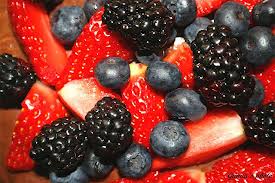 Well, it has taken science a while but it would seem that it is starting to agree with this age old plant signature system of the ancient herbalists. Although this is only a very simplistic start botanists have tentatively concluded that the colors red, blue and purple in plants is associated with powerful antioxidants and from that they are saying that healthy aging, better overall health, a lowered risk of cancer, memory functions and urinary tract health are as result. This is no revelation. Herbalists can already explain why this is so. They’re just waiting for the science to catch up. A list of ingredients alone does not explain how herbs work or why and it never will completely.
Well, it has taken science a while but it would seem that it is starting to agree with this age old plant signature system of the ancient herbalists. Although this is only a very simplistic start botanists have tentatively concluded that the colors red, blue and purple in plants is associated with powerful antioxidants and from that they are saying that healthy aging, better overall health, a lowered risk of cancer, memory functions and urinary tract health are as result. This is no revelation. Herbalists can already explain why this is so. They’re just waiting for the science to catch up. A list of ingredients alone does not explain how herbs work or why and it never will completely.
At the Università Politecnica delle Marche in Italy the skin protective properties of strawberry extract were put to the test. It was found that “fibroblasts,” which are common connective tissue cells, prepared with some strawberry extract exhibited photoprotective properties when exposed to UV light. In other words, strawberry extract provoked the cells into protecting themselves from the UV rays.
Of course the interest of this research is in creating some sort of sunscreen out of strawberries but, if an extract from strawberries can do this topically, then it would seem that were the strawberries to be eaten, that between their natural chemical constituents, their natural tendency to remove toxins, their natural ability to be cooling that they may very well help prevent or lessen a sunburn in the normal course of them nourishing the body as a whole.
The principle behind these effects are related to organ functions. The skin has often been called the body’s largest organ. And, the skin works very closely with kidney functions. Given that the strawberries have long been associated with kidney functions it makes sense that they should also, in some way, aid the skin on a macro scale.
In this vein it should also be considered that on a micro scale, every living cell maintains itself from being fed by it’s host – the body. It could not feed itself if it did not have a stomach, kidneys and an entire digestive system of it’s own. So, when any one of our main organs is affected by what we may have ingested, so are all the others in every cell by extension.
I have written about this at least 15 years ago and it would seem that this concept is finally being accepted as not only plausible, but fact among some.
There is also another concept to consider. In order to get a sunburn, there has to be something “burnable” in the skin to aggravate it towards being excessively damaged. Some may  laugh at the very notion but, as the concept of toxicity in the body becomes more recognized and accepted, what these toxins do to human body tissue will become more apparent than they already are. After all, in places where people lived in the open Sun with practically no clothes to protect their skin, sunburn, skin discolorations and skin cancer have never been a problem.
laugh at the very notion but, as the concept of toxicity in the body becomes more recognized and accepted, what these toxins do to human body tissue will become more apparent than they already are. After all, in places where people lived in the open Sun with practically no clothes to protect their skin, sunburn, skin discolorations and skin cancer have never been a problem.
To better illustrate this point; in principle, it is understood that in the process of smelting metals or in producing any other man made material, that the freer that material is of contaminants or other unwanted impurities, the better the overall integrity of that material will be, as will the reliability of its performance. If we have an appreciation for this basic concept in our own works, why should Nature not utilize it in Her own creations?
It is clear that our skin, as well as all of our bodily tissue, being much finer than our own creations, cannot perform their tasks with bits of foreign materials imbedded in them. Then would not finer but misplaced biological contaminants have a similar effect? Very fine, left over contaminants that have not been metabolized out of our fibers, like a room occupied by unwanted intruders, impede the overall functioning of those fibers. They are weakened by it and made subject to natural forces and outside influences.
The skin is an eliminatory organ in itself. Should the skin be exposed to the Sun while having contaminants in it, there can be reactions because of them and their concentration. Logically, anything that is in our body that should not be there is incapable of functioning in harmony with it. And, the body does all it can to remove it. Should it find itself in the skin, then that is where the effect will take place. If exposed to the Sun while the body is not able to metabolize it, the result could be skin cancer, permanent discoloration of the skin, or a more severe sunburn than should have occurred.
It is not being said that by eating strawberries a person is immune to sunburn or the general effects of the Sun. No, that would be ludicrous. But, if through the gentle cooling and detoxifying effect of strawberries a person is made a little less prone to it, it might be helpful.
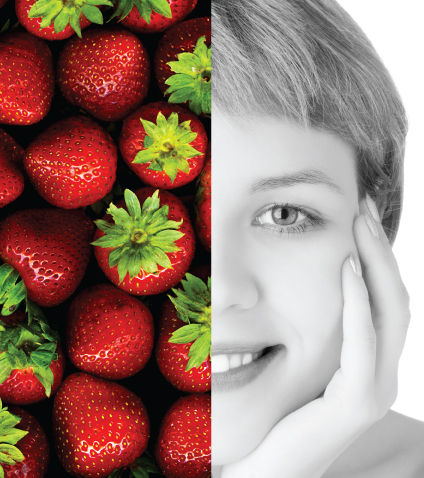 When I was eating nothing but raw fruits and vegetables, I would tan but rarely felt a sun burn. That may not constitute scientific proof but, it was certainly my experience and also that of those whom I knew that had eaten as I had.
When I was eating nothing but raw fruits and vegetables, I would tan but rarely felt a sun burn. That may not constitute scientific proof but, it was certainly my experience and also that of those whom I knew that had eaten as I had.
The moistening, moisturizing, cleansing, and naturally cooling effect of strawberries makes them ideal for a moisturizing facial. All that needs to be done is to puree the strawberries with some honey and yogurt and apply it onto the face and massage it in. It would need to be left on the face for at least 15 -20 minutes for the effects of the ingredients to work their magic. When done, they are simply washed off with cool water.
Given that the ingredients are gentle and do not strip the skin, this can be done of a few days to up to a week. Your skin will thank you.
Some Final Thoughts
It would seem that strawberries do indeed have a several benefits. The main affect from those benefits is ultimately as a powerful blood cleanser. The body only has a limited number of systems to work with, the main one being digestive or, in support of it. Provoked detoxification can only be explained through a specific digestive system stimulation that some natural remedies like strawberries can provide. The detoxifying effect of strawberries might be explained through their direct impact on digestion itself, through their effect on the kidneys and their general benefit to the stomach.
(the concept that the kidneys affect the digestion that goes on in the stomach is one that is unlikely accepted by modern medicine – at least not yet)
All of these recorded effects associated with strawberries go far beyond what their chemical composition could ever explain on its own. This suggests that a chemical analysis of any living thing is never 100% complete. The several dozen recognized ingredients in strawberries surely have several hundred or more besides them that cannot yet be recognized and their usefulness or relation to effects determined.
Having said all this, although the cooling and detoxifying effect of the fruit may still be taken advantage of, the rest of the plant, from having been artificially fertilized and chemically sprayed should not be used unless picked in the wild free from any contamination.
Having Fun With Strawberries
Health is not about measuring everything you eat as though it were a lab experiment. Healthy people all over the world eat foods in their raw state but also prepare them for the shear enjoyment of eating them. The main difference between eating and enjoying food and eating and making yourself sick, is in the ingredients being used in what is being eaten.
If all a person eats has had all the goodness and nutrition processed out of it and has been laced with a cocktail of preservatives – Why Eat It!!! The only “big secret” to eating healthy is about eating fresh food, eaten while freshly prepared.
Here are some recipes that can be enjoyed by those who love strawberries. Just click on the picture that looks most appetizing and it will take you to a fabulous recipe.





